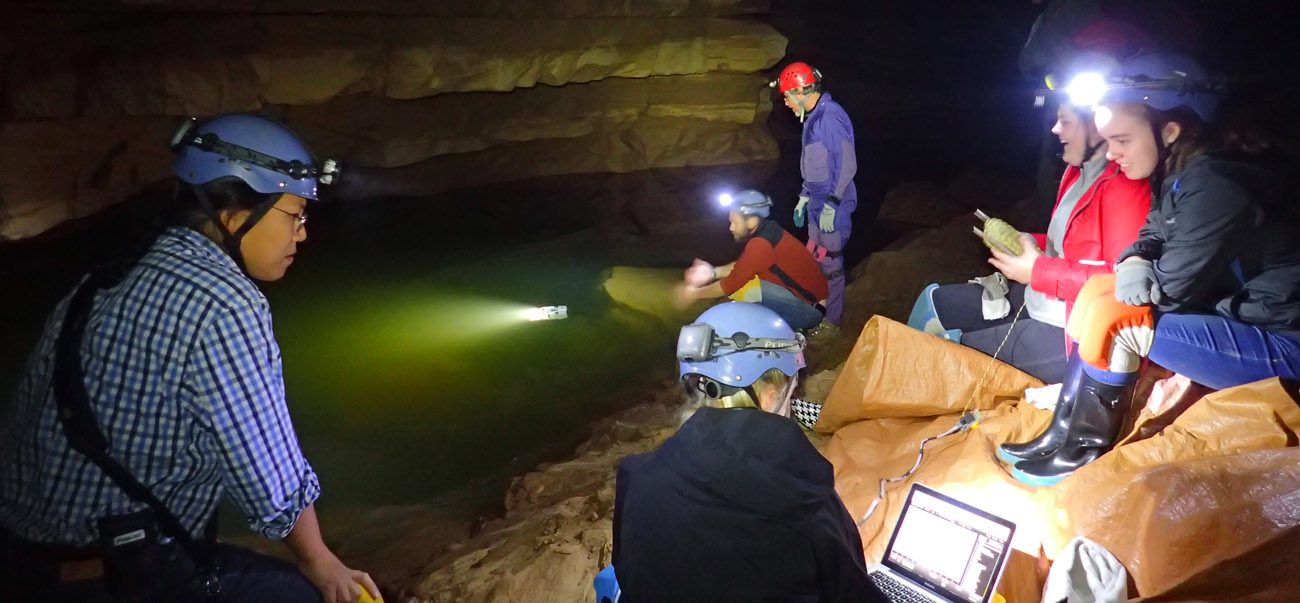LOUISVILLE, Ky. (CNS) — A group of students from an all-girls Catholic high school in Louisville has been exploring Mammoth Cave National Park’s underground waterways this school year using submersible remotely operated vehicles and high-definition cameras.
The Mercy Academy students recently presented their findings at the Western Kentucky University Research Symposium, held at Mammoth Cave in mid-April.
The students have found a rare species of cave fish and a sunken boat, believed to be from the 1800s. And their work isn’t over.
[hotblock]
They also are mapping the cave’s aquatic floor and trying to determine where water enters the cave, said Steve Hammer, an engineering design teacher at Mercy who is leading the project.
Students in Hammer’s engineering design class began the project last fall from scratch. First, the students built and programmed the submersible robots, known as ROVs, to learn about this form of robotics. The devices are 12 inches long, 8 inches wide and 6 inches tall. The students had already worked with drones and autonomous vehicles in other classes.
Hammer said he contacted representatives of several locations, asking if they’d allow the students to test their ROVs.
“We were pretty excited” when Mammoth Cave’s representatives responded in the affirmative, Hammer told The Record, newspaper of the Archdiocese of Louisville. “They were incredibly excited, too, because this had never been done at Mammoth Cave.”
Mercy Academy, which is operated by the Sisters of Mercy, submitted a two-year research proposal, with the option for an extension, to the National Park Service before the work began.
The ROVs, which were built and programmed by students mostly after school, were attached to 140 meters of tether and two wire interfaces that connected them to the computer. The students introduced them into the cave last fall and piloted the robotic submarines via the Internet.
During their journeys into the cave, the ROVs transmitted information, such as the depth they had submerged, the water temperature and live high-definition video.
Claire Curry, a junior who is part of the engineering design team, said she had always liked science and jumped at the chance to take the engineering design class.
“When I heard we’d be building drones, I thought that was super cool,” said Curry, who added that the STEM (science, technology, engineering and math) program at Mercy gives girls a chance to explore the sciences.
Mercy Academy started its STEM program two years ago. In January, the high school became the first all-girl school in the nation to receive STEM certification from AdvancED, a national nonprofit accrediting organization.
Julianne Wine, a junior who also is on the engineering design team, said she was intrigued by the prospect of building an ROV. Both students noted that it took a lot of team work to put the robots together and to pilot them in the cave.
Curry and Wine were in attendance at the April 18-20 symposium, which also was a new experience for them, they said.
The students presented their findings to research scientists, graduate students and undergraduate students, among others.
[hotblock2]
“It was nerve-wracking, but a great opportunity for a high school student,” said Wine. She noted that it was “extraordinary” to realize that they could do the same amount of work as a college student.
Curry said she was a bit intimidated by all the professionals around her. She said that many seemed interested and asked questions about the technology, their findings and the future of the project.
Hammer said the young women “could not have done a better job.”
“As a teacher, I could not have been more proud,” he said.
“They presented their findings with composure and poise. It was fantastic to see. It was evident that they took everything they’ve learned and presented it in the best light possible.”
The ROVs have traveled to depths in the cave that have never been explored before, said Hammer.
“Hopefully, our research will help to solve some of those unknowns that exists right now,” he said.
Hammer added that Mercy is nine months into the two-year project. The students will continue to help researchers gather data from the cave and continue to present their findings, he said.
***
Thomas is a staff writer at The Record, newspaper of the Archdiocese of Louisville.
PREVIOUS: Martyrs’ Shrine could have new ownership; plans for its future underway
NEXT: Chicago Archdiocese announces new parental leave policy to start July 1




Share this story